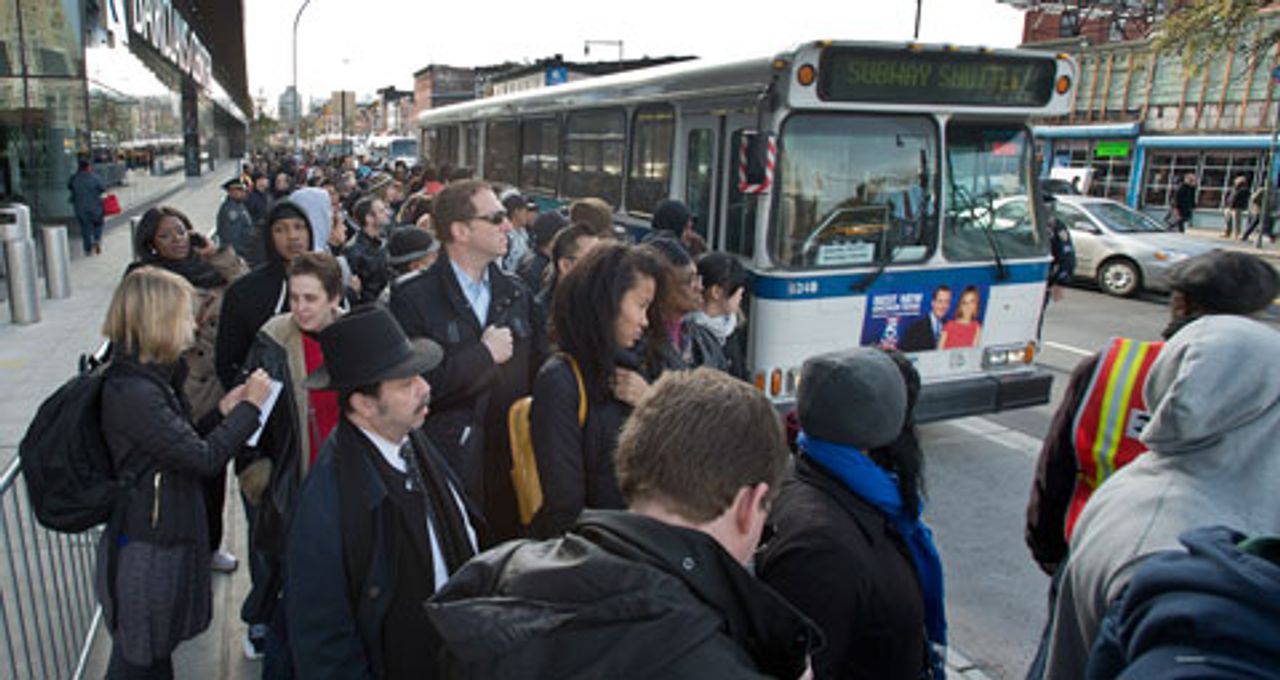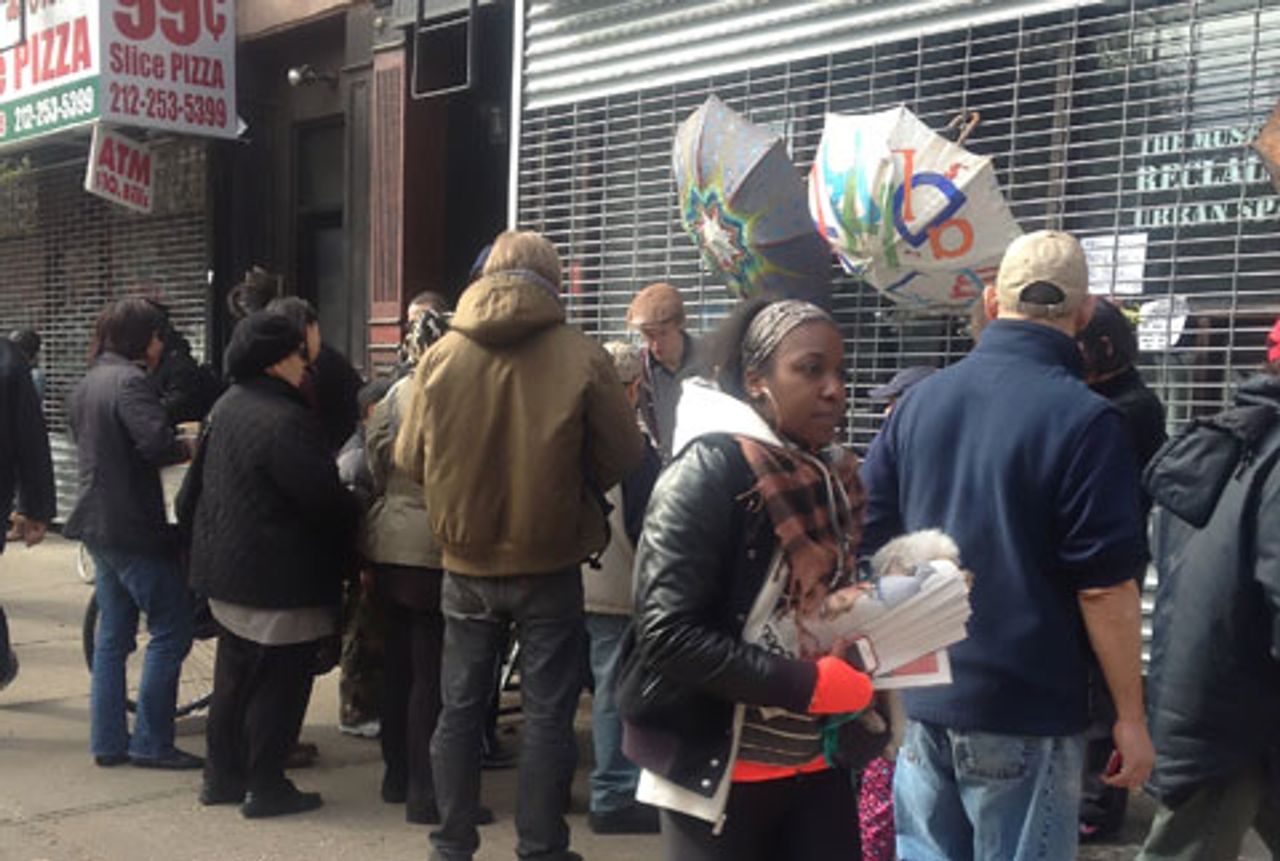There is growing popular anger in New York, New Jersey and throughout the US Northeast, amidst widespread power outages and gasoline shortages in the wake of Hurricane Sandy. The US death toll rose Thursday to at least 90 people in the US and two in Canada. The storm earlier claimed at least 67 lives in the Caribbean.
Tens of millions of people in the Northeast confront traffic gridlock, long lines at gas stations, and public transit that is nonexistent or patchy at best. People are struggling to find a means to get to work, while others remain at home with no electricity, heat, refrigeration or elevator service. Some residents are still trapped in their homes, surrounded by fetid floodwaters.
 Commuters seeking to get into Manhattan on MTA shuttles as subway tunnels remained shut down [Photo: MTA Patrick Cashin]
Commuters seeking to get into Manhattan on MTA shuttles as subway tunnels remained shut down [Photo: MTA Patrick Cashin]More than 4.5 million people remain without power, stretching as far north as Maine and south to North Carolina. This includes about 2.5 million people in metropolitan New York. In New York City, utility giant ConEd said the 228,000 without power in Manhattan should have it back by Saturday, leaving another 400,000 elsewhere in the city in the dark. The company estimated that some New Yorkers would not have power back until November 11, some two weeks after the storm hit.
In the hardest hit state of New Jersey, 1.8 million homes and businesses still had no power as of Thursday. In New York and Connecticut, 17 percent were without power. Some 15 percent of West Virginia customers still lacked power after up to three feet of snow fell in some areas of the state. Pennsylvania outages were down to 8 percent.
The death told in New York City alone has risen to 38, with 19 of these deaths in the borough of Staten Island. There is growing anger in the borough over the slow pace of government action, even as resources have been quickly mobilized to reopen Wall Street and restore functionality to luxury apartment complexes.
 In lower Manhattan, people looked through
In lower Manhattan, people looked through discarded food in dumpsters
“I think that we are not getting the attention because we are a working class neighborhood, and [they are saying] fend for yourselves,” one Staten Island resident told NBC News. Bodies continue to be found in the flood waters, including two young boys, aged 2 and 4, who were swept from their mother’s arms.
Staten Island residents criticized the decision of Mayor Michael Bloomberg to go ahead with this Sunday’s New York Marathon. They charged that the prestige event will divert vital resources while hundreds of thousands of city and metropolitan area residents are still without power, and are running short of food, fuel and other supplies.
There are, however, large amounts of money and corporate interests at stake in the marathon. Bloomberg responded to criticism by saying, “It’s a great event for New York, and I think for those who were lost, you’ve got to believe they would want us to have an economy and have a city go on for those that they left behind.”
The threat of a major gas supply crisis is growing, as commuters and taxi operators attempt to fuel their vehicles and people line up outside gas stations to fill containers to power generators and pumps to clear out flood damage. New York taxi companies started pulling vehicles off the road on Thursday as gas supplies began to dwindle.
Ralph Bombardiere, executive director of the New York State Association of Service Stations, reported that in New York City “over 50 percent of service stations are not able to sell gasoline and it could be up to 75 percent.” Gasoline retailer associations in New Jersey said more than 80 percent of service stations in the state were shut.
Stations either have no gas or no power to pump it. Fuel supplies into New York and New Jersey are being choked off both by problems at refineries and delivery difficulties. Two refineries that account for a quarter of the region’s gas and diesel supply stand idle due to power outages and flooding. In addition, major New York import terminals are damaged and powerless.
In Lower Manhattan, however, giant generators used to power the New York Stock Exchange and large banks continue to be supplied with adequate fuel. Meanwhile, many public housing residents in the area remain without power, heat and water, virtually ignored by city authorities and the media. (See “New York City public housing without lights, heat or water after storm”)
 People waiting for food being distributed
People waiting for food being distributedThe partial resumption of service on 14 or the city’s 23 subway lines did little to alleviate the transportation nightmare facing those trying to commute to work or leave their powerless neighborhoods.
The seven tunnels beneath the East River remain flooded, and the Brooklyn-Battery, Queens-Midtown and Holland Tunnels remain closed. Many train lines are operating with large gaps in the routes, and there is no subway service at all below 34th Street.
People lined up for blocks to board MTA buses, waiting hours on end. Authorities enforced a three-passenger minimum for vehicles driving over bridges to Manhattan.
Many drivers said their commute took several hours longer than usual; some gave up after hours-long waits in traffic and in lines that stretched for miles to cross bridges into Manhattan. Some who were able chose to walk instead of wait on buses or haggle for taxis in short supply. Bicycles were a major mode of transport on the darkened streets of Lower Manhattan.
Across the Hudson River, in Hoboken, New Jersey, 25 percent of the city’s residences remain underwater, and a majority have no power. Thousands of residents remain stranded in apartment buildings, surrounded by waist-high contaminated water.
Along the New Jersey coastline, residents able to return to their homes are witnessing scenes of devastation. The storm, which came aground here, beat back and reshaped the shoreline, tossing boats in the air like toys, throwing sand inland, and uprooting homes at their foundations.
In Point Pleasant Beach, about half of the mile-long boardwalk was either destroyed or seriously damaged. The town of Seaside Park remains underwater, and a fire in the town of Mantoloking destroyed 14 homes when firefighters were unable to reach the blaze.
Residents who evacuated some of the barrier islands along the Jersey shore have not yet been able to return to assess the damage, as New Jersey Governor Chris Christie issued an order that residents wait until conditions improve. Many roads in the state remain impassable, and open gas lines and fallen trees pose a potential danger.
The slow pace of the recovery for those affected by the storm brings with it the danger of economic devastation for families and small businesses, as well as threats to health. The total economic damage from Sandy could run as high as $50 billion, according to new estimates from Eqecat, more than double earlier estimates from the forecasting firm.
Many small businesses remain closed. The longer they do translates into not only lost business for owners, but lost wages for the workers they employ. While large businesses take out insurance against business interruptions, small businesses find premiums for such coverage prohibitive and are far less likely to do so. Hourly workers, whose workplaces are shut down or who have no way to get there, have no insurance to cover the wages lost.
In many places, floodwaters are a toxic stew. Tina Tan, state epidemiologist for the New Jersey Department of Health, told National Public Radio, “Floodwaters potentially could contain mixtures of a variety of chemicals such as pesticides, paint, gasoline … things for example that you might store in your garage or your basement.”
In some areas, sewage treatment plants have been sidelined by fires or flooding, posing the spread of bacteria and other pathogens that might make people sick. Consumption of spoiled food due to lack of refrigeration increases the risk of foodborne illness.
The improper use of generators poses the threat of carbon monoxide poisoning, while downed power lines pose the risk of electrocution. As waters recede, mold can begin growing, triggering allergies, asthma attacks and other conditions.
